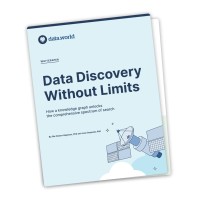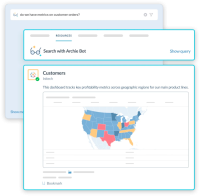When it comes to building a winning data culture, everyone’s looking for a new process, technology, or methodology that is going to help them turn the corner. Meeting with customers, prospects, and analysts, we hear about a lot of them, but there are three enterprise data management trends that stand out above all others.
Trend #1: Data as a product
If you’ve spent any amount of time on LinkedIn or Twitter lately, you likely already know what the first one is: treating data as a product.
This topic is coming up more and more often – and for good reason. Productized data that has an owner with well-documented meaning/semantics/knowledge is easier for consumers to discover, understand, and use than raw data that lives in a data lake.
We’re two decades into the twenty-first century, and the majority of enterprise organizations continue to struggle in their quest to derive true value from data. Given the volume, velocity, variety, and veracity of data coming in, it is understandable that enterprises need to add new parameters – and people – to manage it.
Treating data as a product means bringing product thinking to data management. Product management teams care deeply about whether end users are getting value from the product and consider factors like feasibility, usability, viability, maintainability, reusability, and scalability in their decision-making. Data product management teams can serve the same role for data.
Mammad Zadeh, former VP of Engineering at Intuit, talked about the shift towards treating data as a product on an episode of Catalog & Cocktails. Give it a listen to learn more about his perspective and why this is a necessary move.
Trend #2: Data product managers
After reading about the rising tide in data productization, it should come as no surprise that the second trend CDOs can’t stop talking about is the need for data product managers.
A data product manager is essential for treating data as a product. The role operates similarly to a product manager in software development. Just as a product manager serves as a bridge between software engineers and software users, data product managers align the needs of data consumers to the outputs of data producers to ensure the data meets the requirements of all end users.
Data product managers are intimately familiar with the data ecosystem of their given domain, understanding not just data sources and pipelines, but also the key stakeholders, initiatives, and long-term strategies that their data fuels. They are responsible for documenting requirements and sharing knowledge from both data producers and consumers, defining a road map in order to generate and manage a clean, reliable, and meaningful data product.
Data wrangling and cleaning tasks should also fall under data product management, but this is much more than eliminating white spaces, replacing wrong characters, and normalizing dates. Data product managers:
- Debate with stakeholders to document data definitions
- Define the schemas and models of what data means
- Ground the meaning across disparate data sources
- Maintain a data catalog
- Apply agile methodologies to deliver reliable data without boiling the ocean
If you’d like to know more about the role of a data product manager and why it is important, we dive deeper into the topic on this episode of Catalog & Cocktails.
Trend #3: Semantic layer
Last but not least on our list of top enterprise data management trends, is the semantic layer.
A semantic layer maps data to familiar business terms such as product, customer, or revenue, and offers a unified, consolidated view of your data across the organization. It is important because it eliminates data brawls and speeds time-to-insight by aligning stakeholders to shared, consistent definitions of data.
In fact, the promise is so great – and the demand so high, that dbt Labs is making a substantial investment to add a single open semantic layer of dbt code. According to dbt Labs CEO and founder Tristan Handy, “This will solve, once and for all, one of the biggest problems in our space: the ‘single-source-of-truth’ problem.”
At data.world, we’ve believed in the power of the semantic layer since day one – it’s why our data catalog was the first in the space to be built on a knowledge graph. Knowledge graphs are modern data infrastructure that connect data and metadata to all users in an organization, providing a single semantically organized view of your data. They are unique in that business terminology is represented as concepts and relationships that are both understandable by people and machines in the exact same way.
data.world customer Luke Slotwinski, VP of Data and Analytics at Prologis, appeared on Catalog & Cocktails to discuss how his team leverages the semantic layer to answer the why behind data challenges.
What do all three trends have in common?
The tie that binds all three trends together is data mesh. (What, you thought you’d read an article on enterprise data management that doesn’t mention it?)
Knowingly or not, many organizations are already practicing – or pursuing – data mesh principles. That’s because, despite its detractors, data mesh offers a new approach to enterprise data management that instills hope in data and analytics teams with the promise of brighter days ahead.
Want more mesh? Join us on April 7th for the data.world spring summit where data.world co-founder and CPO Jon Loyens, Monte Carlo co-founder and CEO Barr Moses, Gary George from Indeed, and a special guest from Snowflake will participate in a panel discussion on what comes next for data mesh.




